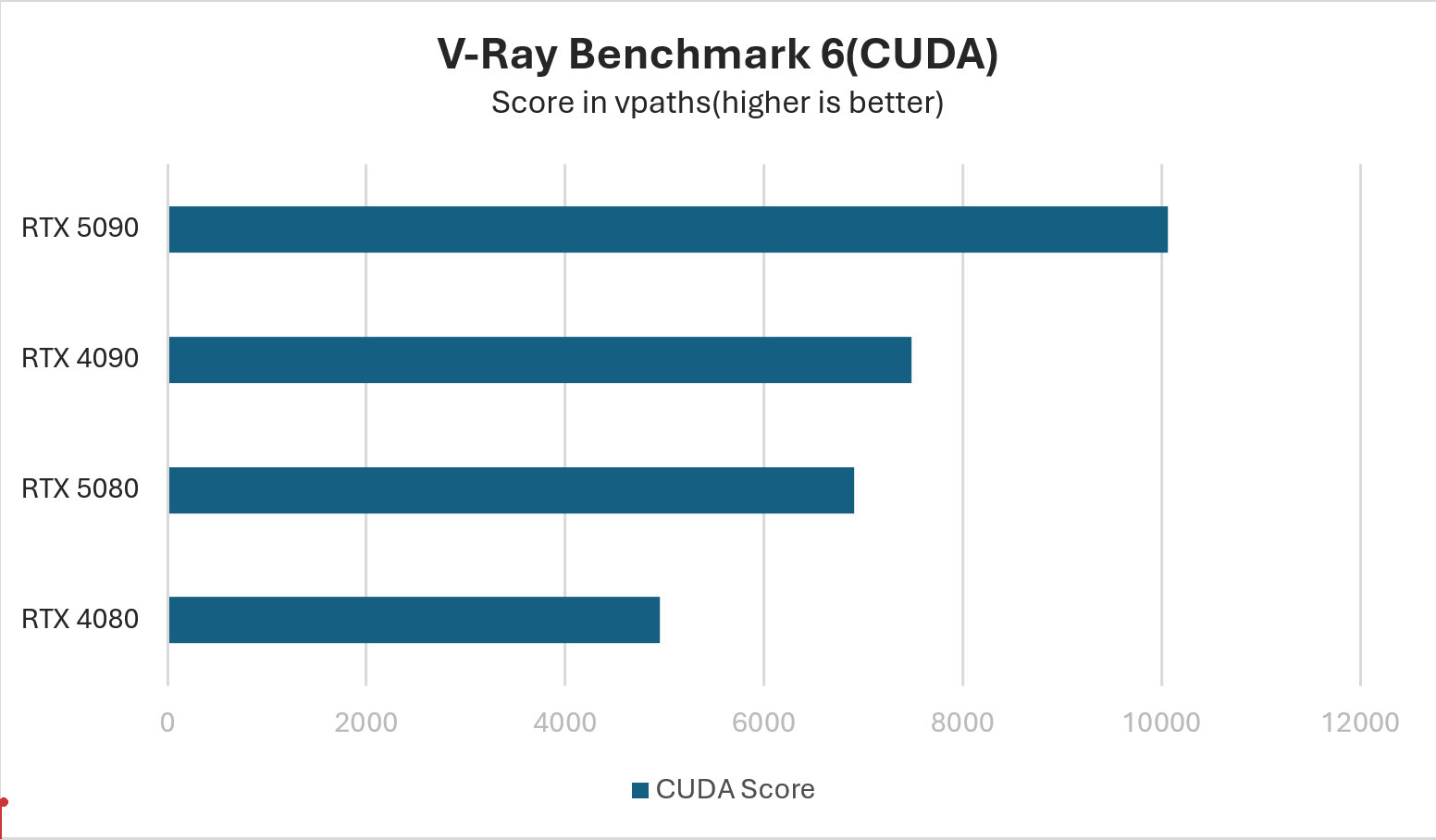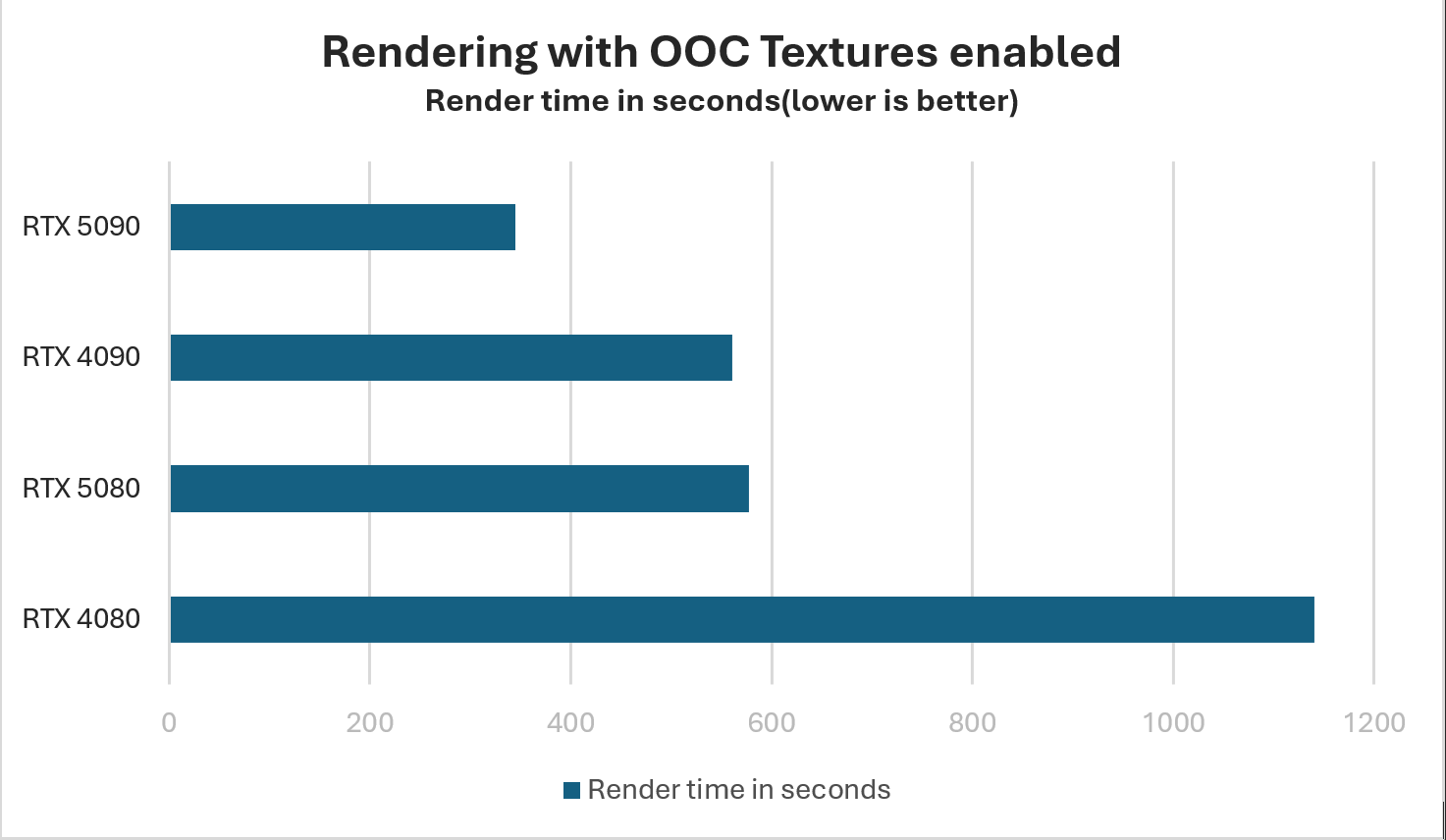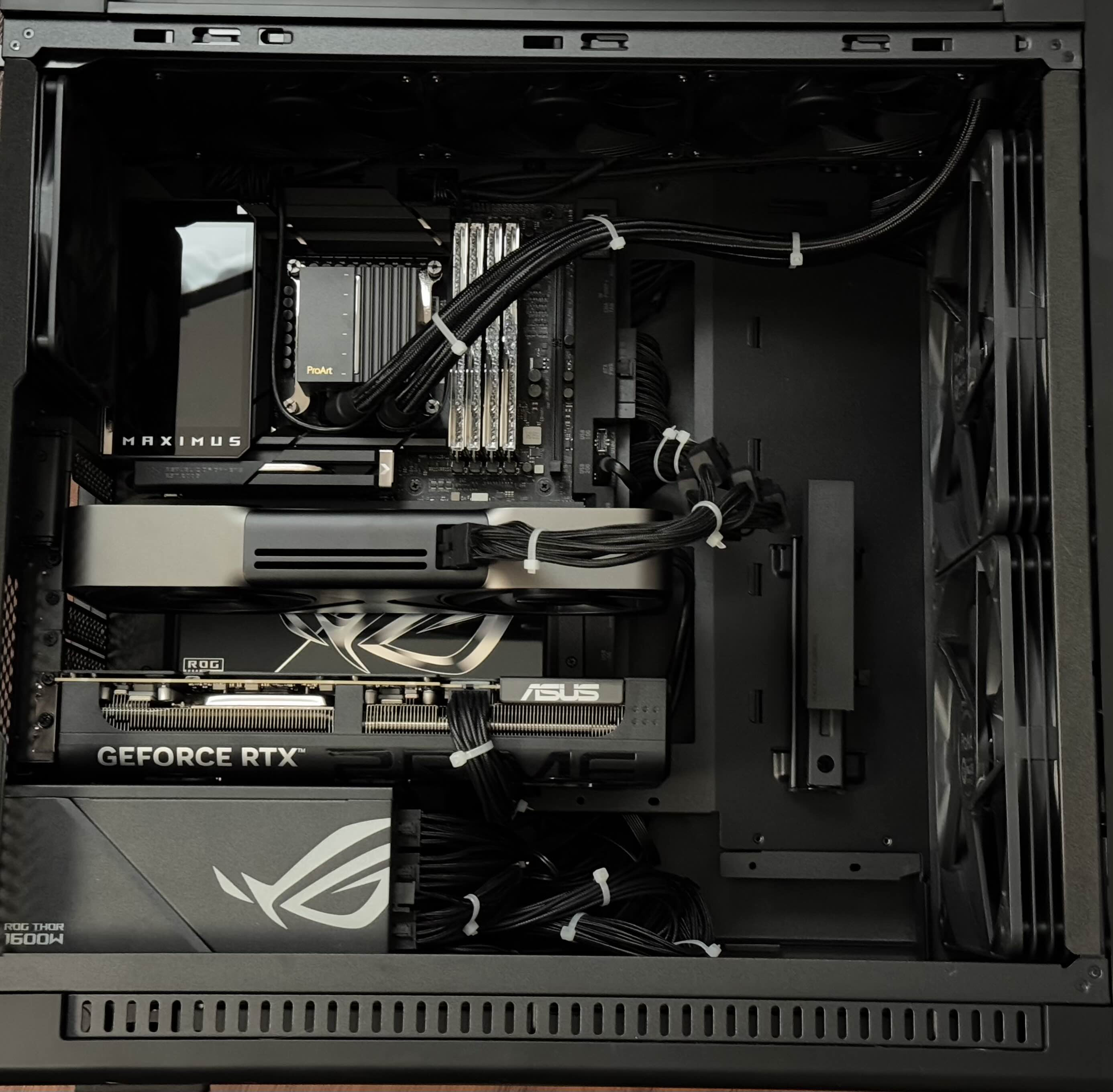Introduction,
Nvidia has encountered some challenges this generation. Although the RTX 50 series uses cutting-edge technologies like PCI Express 5.0 and GDDR7 memory, it is still using the same TSMC 4N process as last generation. Nvidia opted to create a larger and more powerful GPU. The die size on the RTX 5090 has increased by 23%, and it now features 33% more cores. It is equipped with 32 GB of GDDR7 memory on a 512-bit memory bus, providing an impressive bandwidth of 1,792 GB/s—an increase of 78% compared to the RTX 4090.
The RTX 5090 is the most powerful GPU in the market, but Pricing for the flagship GPU increased from 1600$ for the RTX 4090 to 2000$ for the RTX 5090, a 25% increase in pricing(the current pricing is much higher because of supply issues, it will take a few weeks for prices to come down. If you plan on buying the new GUPs it is best to wait for the pricing to come down)
Note, the current builds of V-Ray 6 and V-Ray 7 support Blackwell GPUs out of box, no changes are required.

Test System,
CPU: Intel Ultra 9 285K
Memory: 196 GB Gskill TridentZ Royal 6400 MHz
Motherboard: Asus ROG Strix Z890 Exterme
GPU: Asus Prime RTX 5080 16 GB - RTX 5090 Founder's Edition 32 GB
Power supply: Asus ROG Strix Thor 1600 Watts
Case: Asus ProArt PA602 Full-tower
CPU Cooler: Asus ProArt LC 420 MM
The GPUs are running in x8 PCIe Gen 5 in this configuration

V-Ray GPU performance,
Note, All Blackwell testing has been done using the RTX engine, there is a compiler issue that affects the performance of the CUDA engine(cuts it in half almost). This will be fixed in an upcoming Nvidia driver very soon. If you buy any of the new Blackwell GPUs, please use the RTX engine for now.
Edit, this is fixed in driver 572.60
V-Ray Benchmark(RTX)

V-Ray Benchmark(CUDA)

More testing on production scenes,

PCIe Gen 5,
The RTX 5090 is one of the first high-end GPUs to natively support PCIe Gen 5 at the slot, given the motherboard and the CPU also support PCIe Gen 5. In my case I have the Intel Ultra 285k and the Asus Z890 Extreme. With 2 GPUs installed, the PCIe configuration is x8, x8 PCIe Gen 5.
In theory, x16 Gen 4 is the same PCIe bandwidth as x8 Gen 5. When I tested the RTX 4090 in the same PCIe slot I used for the 5090, it would get x16 Gen 4 bandwidth because the RTX 4090 is a Gen 4 device(both the device and Motherboard/CPU need to support Gen 5 to run at Gen 5)

On testing the PCIe bandwidth between x4 Gen 4, x8 Gen 4 and x16 Gen 4 the rendering performance for the RTX 4090 was nearly the same. Interestingly, using Out-Of-Core Textures option(Use System Memory For Textures) I noticed a significant difference on rendering performance for the RTX 5090. This could be because of the PCIe Gen 5 bandwidth or the GDDR7 bandwidth or both
First scene I tested is Int_006 with OOC Textures enabled., it has 12 GB of Textures. The RTX 5090 is 70% faster than the RTX 4090, nearly doubling the speedup we saw in standard rendering.

Second scene is Int_008 with OOC Textures enabled, it has 24 GB of Textures. The RTX 5090 is 79% faster than the RTX 4090, and the RTX 5080 is now much faster than the RTX 4080

In MSI AfterBurner, the RTX 5090 using 100% of the PCIe bandwidth

On the same scene, the RTX 4090 is using 64% of the bandwidth x16 Gen 4

Thermals,
The Founder's edition model has Dual-slot cooler, it runs much hotter and produces a lot more heat than the 4090 when rendering with V-Ray GPU. I'm getting around 70 degrees C while rendering with the RTX engine, and a few degrees hotter when rendering with the CUDA engine, fans are running at around 1600 RPM.
Good airflow is essential in this case(not pun intended), all of this heat builds up inside thecase and makes other components run hotter. If you use a CPU cooler this might be problematic. I'm using 6x Noctua fans for the case airflow.

Power consumption,
The RTX 5090 Founder's Edition has a TDP of 575 Watts, 30% more than the RTX 4090. The RTX 5090 uses the same 12VHPWR as the 4090, it is able to draw up to 600 Watts. The box includes an adapter from 4x 8 pins to the new 12 pin connector. ATX 3.0 power supplies have native 12 pin connectors, at least one. Nvidia recommends a 1000W power supply for the RTX 5090 in most systems
Memory pooling and NVlink,
Blackwell GPUS don't support NVlink. Key Differences Between Blackwell and Ampere/Ada Lovelace: Unified Shared Memory (USM) and Advanced Memory Sharing: Blackwell takes multi-GPU memory sharing to the next level by enabling Unified Shared Memory across multiple GPUs. This means that GPUs can share memory much more effectively, even over the PCIe bus without the need for specialized hardware like NVLink. In contrast, the 3000/4000 series also allows multi-GPU setups but benefits more from NVLink for high-bandwidth memory sharing. USM allows multiple GPUs to access the same data without explicit data copying or complex management, which makes it ideal for workloads in AI, machine learning, and computational tasks that require large shared datasets. More about this here
We are working on supporting this memory pooling in V-Ray GPU with Nvidia's help.
Which version of the RTX 5090(or 5080) to buy?
It is quite hard to find the new cards in stock now, there is high demand and smaller supply. My advice is to wait until the end of March if possible until the supply improves, so the pricing comes down close to MSRP, 2000$ for the Founder's Edition of the 5090 and 1000$ for the 5080.
Once the supply is better and given the luxury of choice, I suggest buying the Founder's Edtion version whenever possible. It is the only one that is dual-slot, which gives you space and clearance in your case. Another point is that the FE cards sell at MSRP, 3rd party cards are usually priced higher. If you cannot find the FE version, buy the cheapest version you could find and be mindful of its physical size to make sure it will fit in your case.
Best,
Muhammed
Nvidia has encountered some challenges this generation. Although the RTX 50 series uses cutting-edge technologies like PCI Express 5.0 and GDDR7 memory, it is still using the same TSMC 4N process as last generation. Nvidia opted to create a larger and more powerful GPU. The die size on the RTX 5090 has increased by 23%, and it now features 33% more cores. It is equipped with 32 GB of GDDR7 memory on a 512-bit memory bus, providing an impressive bandwidth of 1,792 GB/s—an increase of 78% compared to the RTX 4090.
The RTX 5090 is the most powerful GPU in the market, but Pricing for the flagship GPU increased from 1600$ for the RTX 4090 to 2000$ for the RTX 5090, a 25% increase in pricing(the current pricing is much higher because of supply issues, it will take a few weeks for prices to come down. If you plan on buying the new GUPs it is best to wait for the pricing to come down)
Note, the current builds of V-Ray 6 and V-Ray 7 support Blackwell GPUs out of box, no changes are required.
Test System,
CPU: Intel Ultra 9 285K
Memory: 196 GB Gskill TridentZ Royal 6400 MHz
Motherboard: Asus ROG Strix Z890 Exterme
GPU: Asus Prime RTX 5080 16 GB - RTX 5090 Founder's Edition 32 GB
Power supply: Asus ROG Strix Thor 1600 Watts
Case: Asus ProArt PA602 Full-tower
CPU Cooler: Asus ProArt LC 420 MM
The GPUs are running in x8 PCIe Gen 5 in this configuration
V-Ray GPU performance,
Note, All Blackwell testing has been done using the RTX engine, there is a compiler issue that affects the performance of the CUDA engine(cuts it in half almost). This will be fixed in an upcoming Nvidia driver very soon. If you buy any of the new Blackwell GPUs, please use the RTX engine for now.
Edit, this is fixed in driver 572.60
V-Ray Benchmark(RTX)
- The RTX 5090 is 39% faster than the RTX 4090
- The RTX 5080 is 15% faster than the RTX 4080
- The RTX 5090 is 61.5% faster than the RTX 5080
- The RTX 5080 is 17% slower than the RTX 4090
V-Ray Benchmark(CUDA)
More testing on production scenes,
- The RTX 5090 is between 22-40% faster than the RTX 4090
- The RTX 5080 is between 12-20% faster than the RTX 4080
PCIe Gen 5,
The RTX 5090 is one of the first high-end GPUs to natively support PCIe Gen 5 at the slot, given the motherboard and the CPU also support PCIe Gen 5. In my case I have the Intel Ultra 285k and the Asus Z890 Extreme. With 2 GPUs installed, the PCIe configuration is x8, x8 PCIe Gen 5.
In theory, x16 Gen 4 is the same PCIe bandwidth as x8 Gen 5. When I tested the RTX 4090 in the same PCIe slot I used for the 5090, it would get x16 Gen 4 bandwidth because the RTX 4090 is a Gen 4 device(both the device and Motherboard/CPU need to support Gen 5 to run at Gen 5)
On testing the PCIe bandwidth between x4 Gen 4, x8 Gen 4 and x16 Gen 4 the rendering performance for the RTX 4090 was nearly the same. Interestingly, using Out-Of-Core Textures option(Use System Memory For Textures) I noticed a significant difference on rendering performance for the RTX 5090. This could be because of the PCIe Gen 5 bandwidth or the GDDR7 bandwidth or both
First scene I tested is Int_006 with OOC Textures enabled., it has 12 GB of Textures. The RTX 5090 is 70% faster than the RTX 4090, nearly doubling the speedup we saw in standard rendering.
Second scene is Int_008 with OOC Textures enabled, it has 24 GB of Textures. The RTX 5090 is 79% faster than the RTX 4090, and the RTX 5080 is now much faster than the RTX 4080
In MSI AfterBurner, the RTX 5090 using 100% of the PCIe bandwidth
On the same scene, the RTX 4090 is using 64% of the bandwidth x16 Gen 4
Thermals,
The Founder's edition model has Dual-slot cooler, it runs much hotter and produces a lot more heat than the 4090 when rendering with V-Ray GPU. I'm getting around 70 degrees C while rendering with the RTX engine, and a few degrees hotter when rendering with the CUDA engine, fans are running at around 1600 RPM.
Good airflow is essential in this case(not pun intended), all of this heat builds up inside thecase and makes other components run hotter. If you use a CPU cooler this might be problematic. I'm using 6x Noctua fans for the case airflow.
Power consumption,
The RTX 5090 Founder's Edition has a TDP of 575 Watts, 30% more than the RTX 4090. The RTX 5090 uses the same 12VHPWR as the 4090, it is able to draw up to 600 Watts. The box includes an adapter from 4x 8 pins to the new 12 pin connector. ATX 3.0 power supplies have native 12 pin connectors, at least one. Nvidia recommends a 1000W power supply for the RTX 5090 in most systems
Memory pooling and NVlink,
Blackwell GPUS don't support NVlink. Key Differences Between Blackwell and Ampere/Ada Lovelace: Unified Shared Memory (USM) and Advanced Memory Sharing: Blackwell takes multi-GPU memory sharing to the next level by enabling Unified Shared Memory across multiple GPUs. This means that GPUs can share memory much more effectively, even over the PCIe bus without the need for specialized hardware like NVLink. In contrast, the 3000/4000 series also allows multi-GPU setups but benefits more from NVLink for high-bandwidth memory sharing. USM allows multiple GPUs to access the same data without explicit data copying or complex management, which makes it ideal for workloads in AI, machine learning, and computational tasks that require large shared datasets. More about this here
We are working on supporting this memory pooling in V-Ray GPU with Nvidia's help.
Which version of the RTX 5090(or 5080) to buy?
It is quite hard to find the new cards in stock now, there is high demand and smaller supply. My advice is to wait until the end of March if possible until the supply improves, so the pricing comes down close to MSRP, 2000$ for the Founder's Edition of the 5090 and 1000$ for the 5080.
Once the supply is better and given the luxury of choice, I suggest buying the Founder's Edtion version whenever possible. It is the only one that is dual-slot, which gives you space and clearance in your case. Another point is that the FE cards sell at MSRP, 3rd party cards are usually priced higher. If you cannot find the FE version, buy the cheapest version you could find and be mindful of its physical size to make sure it will fit in your case.
Best,
Muhammed
Comment